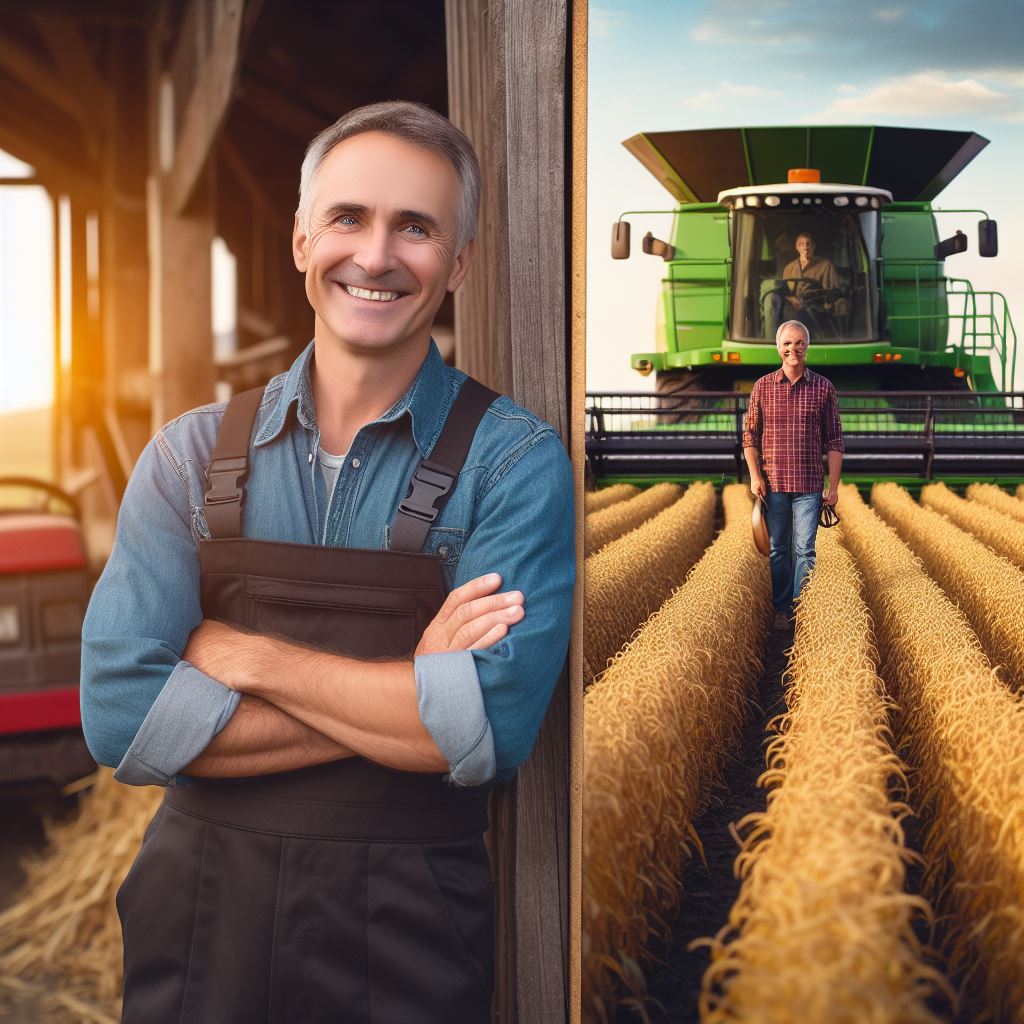Introduction
The Canadian farming industry is diverse and plays a crucial role in the country’s economy.
Understanding the difference between small scale and large scale farming is essential for various reasons.
Overview of Canadian farming industry
Canadian farming encompasses a wide range of agricultural activities, including crop production, livestock farming, and poultry farming.
It is a significant contributor to the country’s GDP and provides food security for the population.
Importance of understanding small vs. large scale farming
Understanding the distinction between small scale and large scale farming allows for better policy-making and targeted support.
It helps identify the unique challenges and opportunities faced by different farm sizes.
Small scale farming refers to family-owned or operated farms that typically have small acreage and limited resources.
These farms contribute to local food production, preserve traditional farming practices, and promote sustainability.
Large scale farming involves commercial operations that cover extensive land areas and employ advanced technologies and machinery.
These farms supply the majority of the nation’s agricultural products and contribute to export markets.
Different scales of farming face distinct challenges, such as access to capital, market competitiveness, and technological advancements.
Additionally, they have varying impacts on the environment, resource utilization, and rural communities.
Understanding the dynamics between small scale and large scale farming is crucial for fostering coexistence and collaboration within the industry.
It allows for the development of innovative strategies that benefit both types of farming operations.
Therefore, gaining insights into the Canadian farming industry and the differences between small scale and large scale farming is vital for sustainable and inclusive agricultural development.
Such understanding enables policymakers, farmers, and consumers to make informed decisions and support the growth of this crucial sector.
Definition and characteristics of small-scale farming
In the world of Canadian agriculture, there are two main types of farming: small-scale and large-scale.
These two approaches differ significantly in terms of farm size, land use, crop and livestock types, as well as farmer involvement in various operations.
Small-scale farming is characterized by its relatively smaller farm size, often ranging from a few acres to a few hundred acres.
These farms are usually family-owned and operated, with the primary goal of sustaining the family’s livelihood rather than maximizing profit.
Small-scale farms often prioritize sustainable and organic practices, aiming to produce high-quality, locally-sourced goods.
The land use in small-scale farming is carefully planned and optimized for maximum productivity.
Farmers focus on diversifying their land, cultivating a variety of crops and raising multiple livestock species.
This approach helps mitigate risks associated with relying on a single crop or livestock sector and promotes sustainable soil and ecosystem health.
In terms of crops and livestock, small-scale farmers prioritize diversity and prioritize traditional and indigenous varieties.
Unlock Your Career Potential
Visualize a clear path to success with our tailored Career Consulting service. Personalized insights in just 1-3 days.
Get StartedThey often cultivate heirloom crops and raise heritage livestock breeds, contributing to the preservation of genetic diversity and cultural heritage.
Small-scale farms may produce a wide range of products, including grains, vegetables, fruits, dairy, poultry, and even honey.
Involvement of the farmer in various operations
One of the defining characteristics of small-scale farming is the deep involvement of farmers in various operations.
They handle everything from planning and planting to harvesting and marketing.
Farmers closely interact with their crops and livestock on a daily basis, allowing for better care, attention to detail, and closer relationships with customers.
Small-scale farming fosters a strong sense of community connection and food sovereignty.
Farmers often sell their produce directly to local consumers through farmers’ markets, community-supported agriculture (CSA) programs, and roadside stands.
By doing so, they establish valuable relationships with their customers, who appreciate the freshness, quality, and traceability of the products they purchase.
Small-scale farming is not without challenges, though.
Limited access to resources such as land, capital, and technology can hinder its growth potential.
Additionally, small-scale farmers often face intense competition from large-scale operations, making it crucial for them to find niche markets and develop innovative marketing strategies.
Despite these challenges, small-scale farming plays a vital role in Canadian agriculture.
It contributes to local food security, biodiversity conservation, and the preservation of traditional farming practices.
Moreover, it helps maintain rural communities and supports sustainable development in both economic and environmental aspects.
Most importantly, small-scale farming in Canada is characterized by its smaller farm size, diverse land use, prioritization of traditional crops and livestock, and deep farmer involvement.
While it faces challenges, it continues to serve as an essential pillar of Canadian agriculture, promoting sustainable practices and fostering community connections.
Read: Challenges Faced by Canadian Farmers
Advantages of Small-Scale Farming
Small-scale farming has gained increasing recognition and popularity due to its numerous advantages over large-scale farming.
Let’s explore some of these benefits:
Promotes local and sustainable food production
Small-scale farms focus on growing local produce, which reduces the carbon footprint associated with transporting food long distances.
They prioritize sustainable farming methods, such as organic or regenerative practices, resulting in healthier and more environmentally-friendly food.
Enhances biodiversity and ecological balance
Small-scale farmers often cultivate a diverse range of crops and raise livestock, which helps maintain biodiversity and prevents the overreliance on a few types of crops or animals.
This approach promotes ecological balance by reducing the risk of pests, diseases, and soil degradation.
Direct relationship with customers and community
Small-scale farmers have the advantage of directly interacting with their customers through farmers’ markets, community-supported agriculture (CSA) programs, or on-farm sales.
This relationship fosters trust, allows for personalized customer service, and creates a sense of community around local food.
Better control over quality and farming practices
Small-scale farmers have greater control over their farming practices and can ensure the highest quality of their products.
They can closely monitor their crops or livestock, implement sustainable pest control methods, and avoid using harmful chemicals or genetically modified organisms (GMOs).
Small-scale farming offers a range of advantages that contribute to a more sustainable and resilient food system.
By promoting local and sustainable food production, enhancing biodiversity, fostering direct relationships with customers, and maintaining control over farming practices, small-scale farmers play a crucial role in building healthier communities and supporting ecological balance.
Read: Organic Farming Trends in Canada Today
Challenges of small-scale farming
Small-scale farming has its fair share of challenges that can make it difficult for farmers to sustain a profitable business.
Here are some of the main obstacles faced by small-scale farmers:
Limited economies of scale
Due to the small size of their operations, small-scale farmers struggle to achieve economies of scale, which refers to the cost advantages gained by producing in larger quantities.
Without the ability to produce large volumes, the cost per unit remains higher for small-scale farmers.
Financial constraints and profitability
Small-scale farmers often face financial constraints that limit their ability to invest in modern technology, equipment, and infrastructure.
This can hinder their overall productivity and profitability, making it more challenging to compete with larger-scale operations.
Difficulty in accessing markets and distribution networks
Small-scale farmers often face difficulties in accessing markets, particularly those dominated by larger agribusinesses and retailers.
Limited resources and lack of bargaining power can lead to exclusion from profitable market opportunities, making it harder for small-scale farmers to sell their products.
Higher workload and lack of specialized machinery
Managing a small-scale farm typically requires a higher workload with limited labor resources.
Compared to larger operations that can afford specialized machinery and equipment for various tasks, small-scale farmers often have to rely on manual labor and face challenges in efficiently completing their work.
Small-scale farming comes with its fair share of challenges.
Limited economies of scale, financial constraints, difficulty accessing markets and distribution networks, and higher workload without specialized machinery are some of the obstacles that small-scale farmers need to overcome to succeed in the industry.
Read: Modern Farming Tech in Canada’s Agriculture
Definition and characteristics of large-scale farming
Large-scale farming refers to the practice of cultivating vast amounts of land and producing high quantities of crops or livestock.
This approach to agriculture involves the utilization of advanced technology and machinery, as well as specialization in commercial crops or livestock.
The characteristics of large-scale farming are defined by extensive land use and the production of high quantities of agricultural products.
Extensive land use and production quantities
One of the notable characteristics of large-scale farming is the extent of land use.
Unlike small-scale farming, which typically involves a limited area of land, large-scale farming utilizes vast stretches of land.
This allows for the cultivation of a large number of crops or the rearing of a significant quantity of livestock.
Another characteristic of large-scale farming is the focus on production quantities.
The key objective of this type of farming is to maximize output.
By utilizing extensive land, large-scale farmers can produce crops or livestock in large quantities, typically for commercial purposes.
This approach to farming aims to meet the demands of an ever-growing population and ensure food security.
Utilization of advanced technology and machinery
Large-scale farming also relies heavily on advanced technology and machinery.
Farmers employ various technological tools such as GPS, drones, and automated irrigation systems to increase efficiency and productivity.
Machinery like tractors, harvesters, and milking machines streamline various farming processes, reducing labor requirements and boosting output.
Specialization in commercial crops or livestock
Moreover, large-scale farming often involves specialization in commercial crops or livestock.
Instead of growing a diverse range of crops or raising various types of livestock, large-scale farmers focus on specific commodities that have high market demand.
Specializing allows them to achieve economies of scale, increasing profitability through bulk production and streamlined marketing strategies.
Through specialization, large-scale farmers can leverage their resources and expertise to produce higher-quality crops or livestock.
This concentration on a specific market niche enables them to optimize production processes, use resources efficiently, and deliver consistent outputs in terms of quality and quantity.
Additionally, large-scale farming facilitates the creation of supply chains and enables direct access to markets.
Due to the large volumes produced, these farmers often have tie-ups with wholesalers, retailers, or export companies, ensuring swift and efficient distribution of their products.
This direct market linkage helps them to receive higher prices for their produce compared to small-scale farmers.
While large-scale farming has its advantages, it also poses some challenges.
The extensive use of land may raise concerns regarding environmental sustainability and the depletion of natural resources.
Furthermore, the capital-intensive nature of large-scale farming may exclude small and medium-scale farmers who lack the financial resources to invest in advanced technology and machinery.
In essence, large-scale farming is characterized by extensive land use, high production quantities, the use of advanced technology, and specialization in commercial crops or livestock.
This approach to agriculture aims to meet the increasing demands of a growing population.
However, it also comes with challenges that need to be addressed to ensure sustainable and inclusive farming practices.
Read: A Day in the Life of a Canadian Farmer

Advantages of large-scale farming
Large-scale farming has several advantages over small-scale farming
Higher production efficiency and yields
One significant advantage of large-scale farming is higher production efficiency and yields.
With access to ample resources, large farms can implement modern farming techniques, utilize machinery, and employ a larger workforce.
This allows them to achieve higher productivity and produce larger quantities of crops or livestock.
Cost-effective due to economies of scale
Cost-effectiveness is another key advantage of large-scale farming.
Due to economies of scale, the cost per unit of production is lower compared to small-scale farming.
Large farms can purchase inputs, such as seeds, fertilizers, and machinery, in bulk, resulting in reduced costs.
This cost advantage translates into higher profits and better financial sustainability for large-scale operations.
Access to global markets and export opportunities
Large-scale farms also enjoy the advantage of accessing global markets and export opportunities.
They have the capacity to meet the demands of international markets and fulfill large-scale orders.
Exporting products to foreign markets can be highly profitable, providing opportunities for growth and expansion.
Small-scale farms often lack the resources and market reach to tap into export markets.
Utilization of advanced technology for precision agriculture
Utilizing advanced technology is another advantage that large-scale farms possess.
They can invest in state-of-the-art equipment and technology, such as GPS-guided machinery, drones, and automated systems.
These technologies enable precision agriculture practices, ensuring optimal use of resources and minimizing waste.
Large farms can also afford research and development activities to stay at the forefront of agricultural innovation.
In fact, large-scale farming offers numerous advantages, including higher production efficiency and yields, cost-effectiveness due to economies of scale, access to global markets and export opportunities, and the ability to utilize advanced technology.
While small-scale farming has its own merits, large-scale farming has the potential to meet the demands of a growing population and contribute significantly to the agricultural sector.
Explore Further: Env. Engineering: Canada’s Fight Against Climate
Challenges of Large-Scale Farming
Environmental Concerns and Impact on Biodiversity
Large-scale farming practices often lead to negative environmental consequences, including the destruction of natural habitats and the loss of biodiversity.
The extensive use of pesticides and fertilizers can contaminate soil and water, harming wildlife and ecosystems.
Moreover, large-scale farms require massive amounts of water and energy, contributing to resource depletion and climate change.
Dependency on External Inputs, such as Chemicals and Fertilizers
Large-scale farms heavily rely on external inputs like chemicals and fertilizers for crop production.
This dependency increases the risk of environmental pollution and soil degradation.
Additionally, the high cost of these inputs can pose economic challenges for farmers, especially during periods of price volatility.
Limited Diversity in Crops and Livestock
Due to the focus on maximizing production and profitability, large-scale farms often prioritize a limited number of highly marketable crops or livestock breeds.
This lack of diversity reduces resilience to pests, diseases, and climate change, putting the entire farming operation at risk.
It also contributes to the loss of traditional and local varieties, eroding agricultural heritage.
Less Engagement with Local Communities and Consumers
Large-scale farming operations are usually less connected with local communities and consumers compared to small-scale farms.
This lack of engagement can lead to a disconnect between producers and consumers, impacting the understanding and awareness of food production practices.
Furthermore, it can hinder the development of local markets and the adoption of sustainable farming methods.
In short, large-scale farming comes with several challenges that cannot be ignored.
Despite its efficiency in meeting global food demands, it poses significant environmental risks.
The reliance on external inputs, limited diversity, and detachment from local communities and consumers further compound these challenges.
To ensure sustainable agriculture in the future, efforts should be made to strike a balance between large-scale and small-scale farming, promoting practices that are environmentally conscious and socially inclusive.
Comparison between small-scale and large-scale farming in Canada
In Canada, farming is a crucial sector that contributes significantly to the country’s economy and provides employment opportunities for many Canadians.
Small-scale farming
- Small-scale farms play a vital role in the local economy by generating income and supporting rural communities.
- These farms often prioritize sustainable and organic practices, promoting environmental preservation.
- They have closer relationships with local communities, allowing for direct consumer-producer interaction.
- Small-scale farmers contribute to food security by producing a diverse range of crops and livestock.
- These farms supply local markets, reducing the need for long-distance transportation and minimizing carbon emissions.
Large-scale farming
- Large-scale farms make significant contributions to the national economy due to their size and production capacity.
- These farms employ a considerable number of Canadians, providing stable and reliable job opportunities.
- Although their focus may be on maximizing output, large-scale farms also invest in sustainable practices.
- They implement advanced technologies, such as precision agriculture, to optimize efficiency and minimize resource use.
- Large-scale farms ensure a consistent food supply, with the ability to meet the demands of a growing population.
Food security and availability
Both small-scale and large-scale farms contribute to food security, but in different ways.
- Small-scale farms play a role in local food systems, ensuring fresh and diverse produce is available.
- Large-scale farms, with their extensive production capabilities, contribute to the overall food supply chain.
Environmental sustainability and conservation efforts
Small-scale farms prioritize sustainable practices, which have positive environmental impacts.
- These farms often use natural fertilizers, crop rotation, and integrate livestock to enhance soil health.
- Large-scale farms also embrace sustainability by adopting technologies that reduce water and energy consumption.
- Efforts such as conservation tillage and precision nutrient application minimize the environmental footprint.
Relationship with local communities and consumers
Small-scale farms have a close relationship with local communities and consumers.
- They sell directly to consumers, fostering transparency and trust in the products they offer.
- Small-scale farmers often engage in farmers’ markets, community-supported agriculture, and farm-to-table initiatives.
Large-scale farms, while more distant from local communities, can still establish beneficial relationships.
- They actively participate in agricultural associations and provide educational programs to engage consumers.
- Large-scale farms also collaborate with local food banks and donate surplus products to support communities.
In review, both small-scale and large-scale farming have their own unique contributions to Canada’s agriculture sector.
The coexistence of these farming practices ensures a diverse and sustainable food system, benefiting the economy, society, and the environment.
Conclusion
Importance of recognizing the coexistence and complementary nature of small and large-scale farming
Recognizing the coexistence and complementary nature of small and large-scale farming is essential.
Both types of farming contribute to a diverse and sustainable Canadian agricultural sector.
It is important to encourage support for both small and large-scale farming to ensure a thriving and balanced industry.
By embracing small-scale farming, we can uphold traditional farming practices and preserve biodiversity.
Small farms often prioritize organic farming methods and are more likely to engage in environmentally friendly practices.
They contribute to the local economy and promote food security at a community level.
On the other hand, large-scale farming plays a significant role in meeting the growing demand for food.
These farms have the capacity to produce crops and raise livestock on a larger scale, ensuring a consistent food supply for the population.
They also contribute to national and international trade, boosting the economy.
Encouragement of support for both types of farming for a diverse and sustainable Canadian agricultural sector
Rather than pitting small and large-scale farming against each other, their coexistence should be celebrated.
Small farms can benefit from the resources and infrastructure available through large-scale farming, while large farms can learn from the sustainability practices of smaller operations.
By supporting both types, we can create a robust and resilient agricultural system.
Government policies and programs should be designed to accommodate the needs of small and large-scale farmers alike.
This includes providing financial support, technical assistance, and training opportunities.
By fostering collaboration and knowledge sharing between farmers of all scales, we can drive innovation and ensure the long-term viability of Canadian agriculture.
Recognizing and supporting the coexistence of small and large-scale farming is crucial for the growth and sustainability of the Canadian agricultural sector.
Embracing both types of farming allows us to preserve tradition, protect the environment, meet food demands, and foster a resilient industry.




